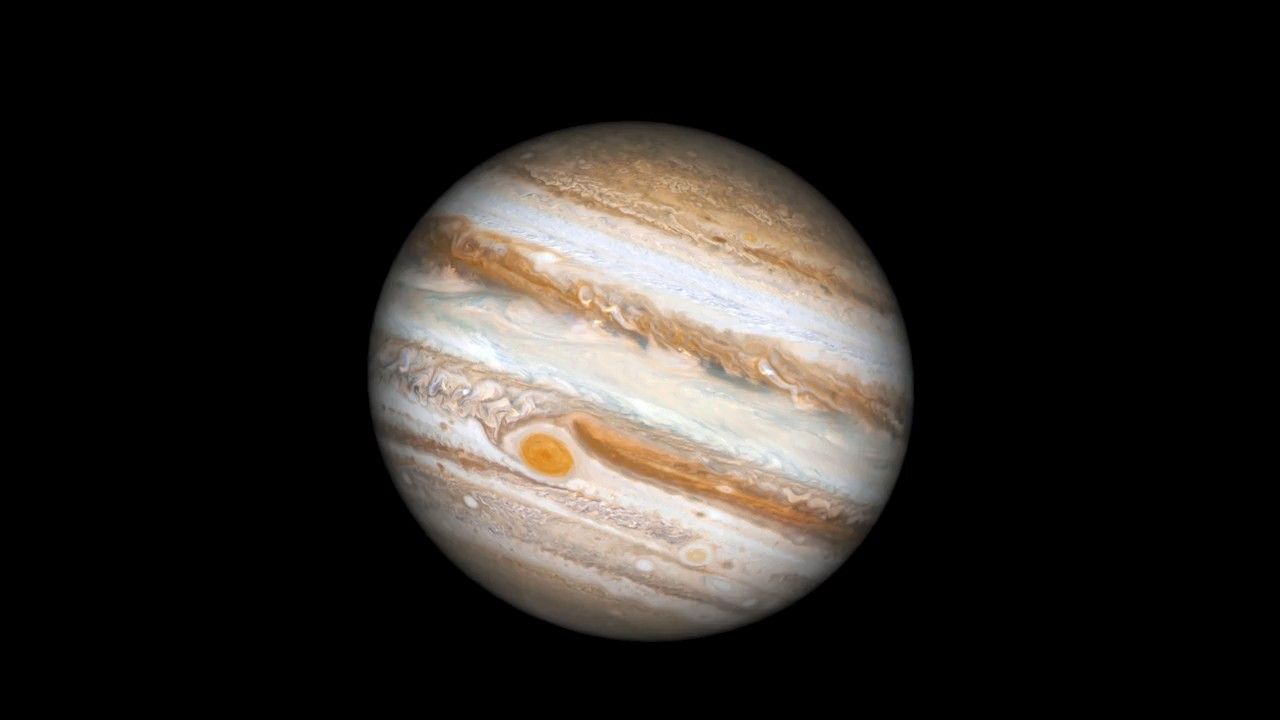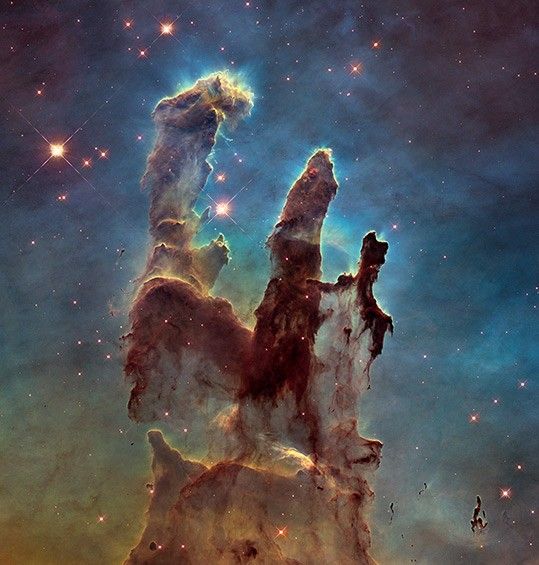1 min read
Jupiter OPAL 2024

This 12-panel series of Hubble Space Telescope images, taken January 5-6, 2024, presents snapshots of a full rotation of the giant planet Jupiter. The Great Red Spot can be used to measure the planet's real rotation rate of nearly 10 hours. The innermost Galilean satellite, Io is seen in several frames, along with its shadow crossing over Jupiter's cloud tops. Hubble monitors Jupiter and the other outer solar system planets every year under the Outer Planet Atmospheres Legacy program (OPAL).
Extended Description and Image Alt Text
Extended Description
This 3-row-by-4-column graphic shows 12 Hubble telescope views of Jupiter, as the planet rotated on January 5-6, 2024. At top center is the label "Hubble Space Telescope Observations of Jupiter." Next to the title are labels "F658N" in red, "F502N" in green, and "F395N" in blue, which represent the filters and colors used to make these images. The date and time label for each view is at the bottom center of each image. From left to right, top to bottom, the images are:
[Top row, column 1]: Jan. 5, 2024 20:46:20 – The planet is banded in stripes of brownish orange, light gray, soft yellow, and shades of cream. Many large storms and small white clouds punctuate the planet. The largest storm, the Great Red Spot, is the most prominent feature in the left bottom third of this view. To its lower right is a smaller reddish anticyclone, Red Spot Jr. Another small red anticyclone appears near the top center of the image.
[Top row, column 2]: Jan. 5, 2024 22:14:56 - The planet is banded in stripes of brownish orange, light gray, soft yellow, and shades of cream. Many large storms and small white clouds punctuate the planet. The largest storm, the Great Red Spot, is the most prominent feature in the right bottom third of this view.
[Top row, column 3]: Jan. 5, 2024 23:47:34 - The planet is banded in stripes of brownish orange, light gray, soft yellow, and shades of cream. Many large storms and small white clouds punctuate the planet. A small red anticyclone appears near the top left in the image.
[Top row, column 4]: Jan. 6. 2024 01:22:30 - The planet is banded in stripes of brownish orange, light gray, soft yellow, and shades of cream. Many large storms and small white clouds punctuate the planet. At upper right of center, a pair of storms appear next to each other: a deep-red triangle-shaped cyclone and a reddish anticyclone. Toward the far-left edge of the image is Jupiter's tiny moon Io. The variegated orange color is where volcanic outflow deposits are seen on Io’s surface.
[Middle row, column 1]: Jan. 6, 2024 02:57:27 - The planet is banded in stripes of brownish orange, light gray, soft yellow, and shades of cream. Many large storms and small white clouds punctuate the planet. Jupiter's tiny moon Io casts a black shadow at Jupiter's far left.
[Middle row, column 2]: Jan. 6, 2024 04:32:23 - The planet is banded in stripes of brownish orange, light gray, soft yellow, and shades of cream. Many large storms and small white clouds punctuate the planet. Toward the far-right edge of the image is Jupiter's tiny moon Io. The variegated orange color is where volcanic outflow deposits are seen on its surface.
[Middle row, column 3]: Jan. 6, 2024 06:07:19 - The planet is banded in stripes of brownish orange, light gray, soft yellow, and shades of cream. Many large storms and small white clouds punctuate the planet. The largest storm, the Great Red Spot, is the most prominent feature in the right bottom third of this view.
[Middle row, column 4]: Jan. 6, 2024 07:42:16 - The planet is banded in stripes of brownish orange, light gray, soft yellow, and shades of cream. Many large storms and small white clouds punctuate the planet. The largest storm, the Great Red Spot, is the most prominent feature in the bottom third of this view.
[Bottom row, column 1]: Jan. 6, 2024 09:17:12 - The planet is banded in stripes of brownish orange, light gray, soft yellow, and shades of cream. Many large storms and small white clouds punctuate the planet. At upper far-left of center, a pair of storms appear next to each other: a deep-red, triangle-shaped cyclone and a reddish anticyclone.
[Bottom row, column 2]: Jan. 6, 2024 10:52:08 - The planet is banded in stripes of brownish orange, light gray, soft yellow, and shades of cream. Many large storms and small white clouds punctuate the planet. At upper right of center, a pair of storms appear next to each other: a deep-red, triangle-shaped cyclone and a reddish anticyclone.
[Bottom row, column 3]: Jan, 6, 2024 14:03:46 - The planet is banded in stripes of brownish orange, light gray, soft yellow, and shades of cream. Many large storms and small white clouds punctuate the planet. A small red anticyclone appears at far right below the equatorial region in the image.
[Bottom row, column 4]: Jan. 6, 2024 15:42:47 - The planet is banded in stripes of brownish orange, light gray, soft yellow, and shades of cream. Many large storms and small white clouds punctuate the planet. The largest storm, the Great Red Spot, is the most prominent feature at far left in the bottom third of this view.
Image Alt Text
This 12-panel series of Hubble Space Telescope images, taken January 5-6, 2024, presents snapshots of a full rotation of the giant planet Jupiter.
About the Object
- DistanceDistanceThe physical distance from Earth to the astronomical object. Distances within our solar system are usually measured in Astronomical Units (AU). Distances between stars are usually measured in light-years. Interstellar distances can also be measured in parsecs.On January 5th and 6th, 2024 Jupiter was 4.56 AU from Earth (about 424 million miles or 682 million km)
About the Data
- Data DescriptionData DescriptionProposal: A description of the observations, their scientific justification, and the links to the data available in the science archive.
Science Team: The astronomers who planned the observations and analyzed the data. "PI" refers to the Principal Investigator.The HST observations include those from program 16995 (A. Simon). Image Processing: Joseph DePasquale (STScI)
- InstrumentInstrumentThe science instrument used to produce the data.WFC3/UVIS
- Exposure DatesExposure DatesThe date(s) that the telescope made its observations and the total exposure time.Jan. 5-6, 2024
- FiltersFiltersThe camera filters that were used in the science observations.F395N, F502N, F658N
- Object NameObject NameA name or catalog number that astronomers use to identify an astronomical object.Jupiter
- Object DescriptionObject DescriptionThe type of astronomical object.Planet
- Release DateMarch 14, 2024
- Science ReleaseHubble Tracks Jupiter’s Stormy Weather
- CreditNASA, ESA, Amy Simon (NASA-GSFC); Image Processing: Joseph DePasquale (STScI)
Downloads

These images are a composite of separate exposures acquired by the WFC3 instrument on the Hubble Space Telescope. Several filters were used to sample medium wavelength ranges. The color results from assigning different hues (colors) to each monochromatic (grayscale) image associated with an individual filter. In this case, the assigned colors are: Blue: F395N, Green: F502N, Red: F658N
Related Images & Videos

Jupiter Compass Image
A side-by-side image titled "Jupiter HST/WFC3/UVIS," shows opposite faces of Jupiter on the black background of space. Below the title is a color key with the filters and colors used to create the images – "F395N" blue; "F502N" green, and "F631N" red. Centered at the bottom is...

OPAL 2024 Jupiter Rotation
The Hubble Space Telescope images used in this animated science visualization present a full rotation of the giant planet Jupiter. This is not a real-time movie. Instead, Hubble snapshots of the colorful planet, taken January 5-6, 2024, have been photo-mapped onto a sphere, and...
Share
Details
Claire Andreoli
NASA’s Goddard Space Flight Center
Greenbelt, Maryland
claire.andreoli@nasa.gov
































